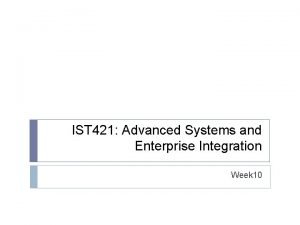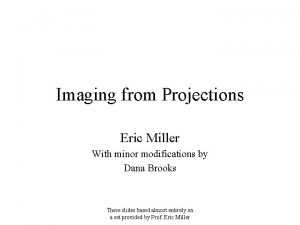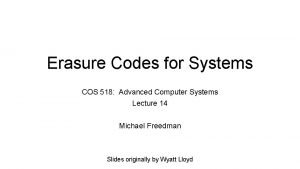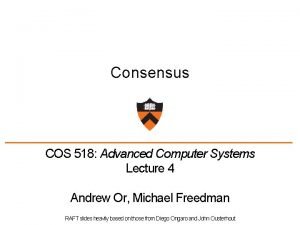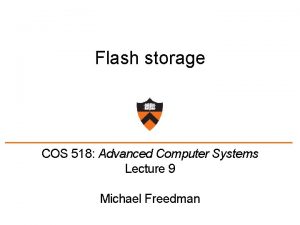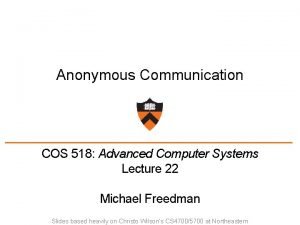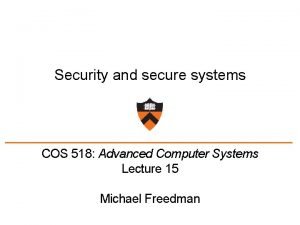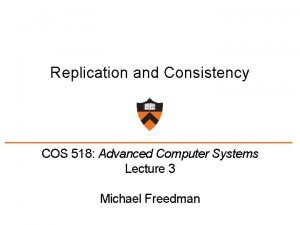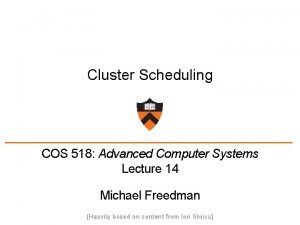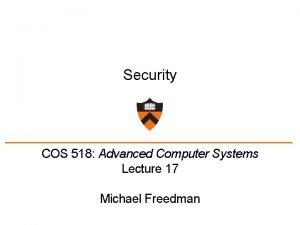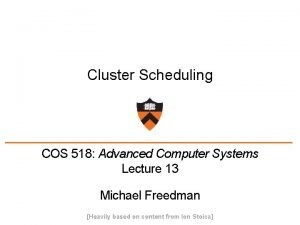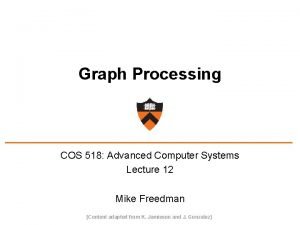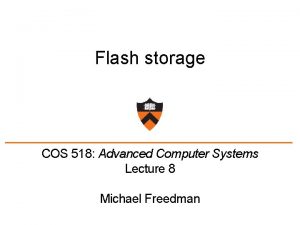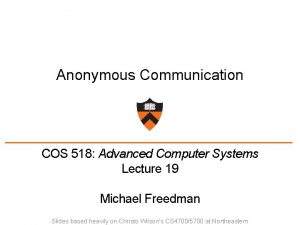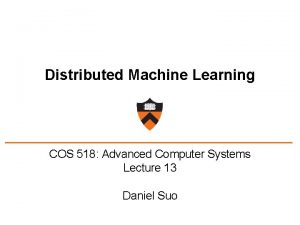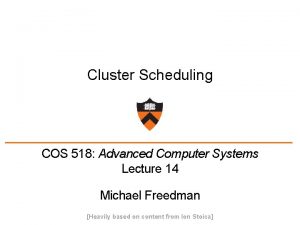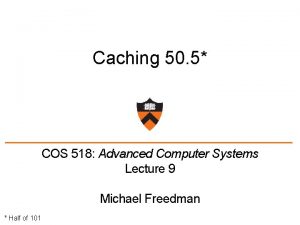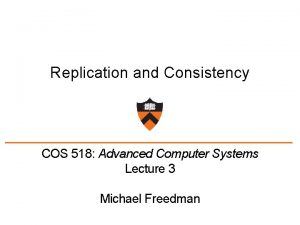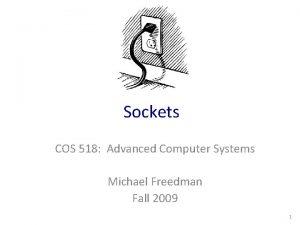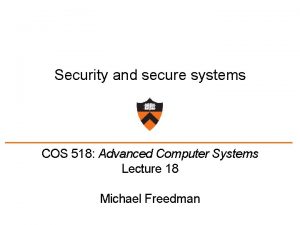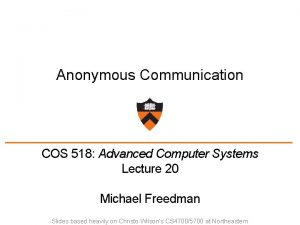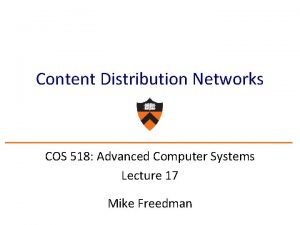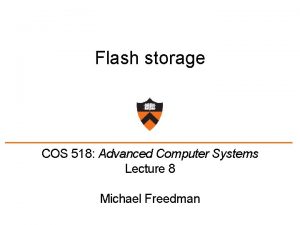Erasure Codes for Systems COS 518 Advanced Computer










































![f 4: Facebook’s Warm BLOB Storage System [OSDI ‘ 14] Subramanian Muralidhar*, Wyatt Lloyd*ᵠ, f 4: Facebook’s Warm BLOB Storage System [OSDI ‘ 14] Subramanian Muralidhar*, Wyatt Lloyd*ᵠ,](https://slidetodoc.com/presentation_image_h2/83fb762ad0dccc38705f0c89a1ec0e14/image-43.jpg)





![Background: Haystack [OSDI 2010] • Volume is a series of BLOBs • In-memory index Background: Haystack [OSDI 2010] • Volume is a series of BLOBs • In-memory index](https://slidetodoc.com/presentation_image_h2/83fb762ad0dccc38705f0c89a1ec0e14/image-49.jpg)










































- Slides: 91

Erasure Codes for Systems COS 518: Advanced Computer Systems Lecture 19 Wyatt Lloyd

Things Fail, Let’s Not Lose Data • How?

Things Fail, Let’s Not Lose Data • How? • Replication • Store multiple copies of the data • Simple and very commonly used! • But, requires a lot of extra storage • Erasure coding • Store extra information we can use to recover the data • Fault tolerance with less storage overhead • Today’s topic!

Erasure Codes vs Error Correcting Codes • Error correcting code (ECC): • Protects against errors is data, i. e. , silent corruptions • Bit flips can happen in memory -> use ECC memory • Bits can flip in network transmissions -> use ECCs • Erasure code: • Data is erased, i. e. , we know it’s not there • Cheaper/easier than ECC • Special case of ECC • What we’ll discuss today and use in practice • Protect against errors with checksums

Erasure Codes, a simple example w/ XOR A B A⊕B

Erasure Codes, a simple example w/ XOR A B A⊕B

Erasure Codes, a simple example w/ XOR A A B = B A⊕B ⊕ A⊕B

Reed-Solomon Codes (1960) • N data blocks • K coding blocks • M = N+K total blocks • Recover any block from any N other blocks! • Tolerates up to K simultaneous failures • Works for any N and K (within reason)

Reed-Solomon Code Notation • N data blocks • K coding blocks • M = N+K total blocks • RS(N, K) • (10, 4): 10 data blocks, 4 coding blocks • f 4 uses this, FB HDFS for data warehouse does too • Will also see (M, N) notation sometimes • (14, 10): 14 total blocks, 10 data blocks, (4 coding blocks)

Reed-Solomon Codes, How They Work • Galois field arithmetic is the secret sauce • Details aren’t important for us • See “J. S. Plank. A tutorial on Reed-Solomon coding for faulttolerance in RAID-like systems. Software—Practice & Experience 27(9): 995– 1012, September 1997. ”

Reed-Solomon (4, 2) Example A B C D 1 2

Reed-Solomon (4, 2) Example A B C D 1 2

Reed-Solomon (4, 2) Example A A B = B C + C D + D 1 + 1 2

Reed-Solomon (4, 2) Example A A B = B C + D 2 1 C + D + 1 = = = A = + 2

Erasure Codes Save Storage • Tolerating 2 failures • 3 x replication = ___ storage overhead

Erasure Codes Save Storage • Tolerating 2 failures • 3 x replication = 3 x storage overhead • RS(4, 2) = ___ storage overhead

Erasure Codes Save Storage • Tolerating 2 failures • 3 x replication = 3 x storage overhead • RS(4, 2) = (4+2)/4 = 1. 5 x storage overhead

Erasure Codes Save Storage • Tolerating 2 failures • 3 x replication = 3 x storage overhead • RS(4, 2) = (4+2)/4 = 1. 5 x storage overhead • Tolerating 4 failures • 5 x replication = 5 x storage overhead • RS(10, 4) = ___ storage overhead

Erasure Codes Save Storage • Tolerating 2 failures • 3 x replication = 3 x storage overhead • RS(4, 2) = (4+2)/4 = 1. 5 x storage overhead • Tolerating 4 failures • 5 x replication = 5 x storage overhead • RS(10, 4) = (10+4)/10 = 1. 4 x storage overhead • RS(100, 4) = ___ storage overhead

Erasure Codes Save Storage • Tolerating 2 failures • 3 x replication = 3 x storage overhead • RS(4, 2) = (4+2)/4 = 1. 5 x storage overhead • Tolerating 4 failures • 5 x replication = 5 x storage overhead • RS(10, 4) = (10+4)/10 = 1. 4 x storage overhead • RS(100, 4) = (100+4)/100 = 1. 04 x storage overhead

What’s the Catch?

Catch 1: Encoding Overhead • Replication: • Just copy the data • Erasure coding: • Compute codes over N data blocks for each of the K coding blocks

Catch 2: Decoding Overhead • Replication • Just read the data • Erasure Coding

Catch 2: Decoding Overhead • Replication • Just read the data • Erasure Coding • Normal case is no failures -> just read the data! • If there are failures • Read N blocks from disks and over the network • Compute code over N blocks to reconstruct the failed block

Catch 3: Updating Overhead • Replication: • Update the data in each copy • Erasure coding • Update the data in the data block • And all of the coding blocks

Catch 3’: Deleting Overhead • Replication: • Delete the data in each copy • Erasure coding • Delete the data in the data block • Update all of the coding blocks

Catch 4: Update Consistency • Replication: • Erasure coding

Catch 4: Update Consistency • Replication: • Consensus protocol (Paxos!) • Erasure coding • Need to consistently update all coding blocks with a data block • Need to consistently apply updates in a total order across all blocks • Need to ensure reads, including decoding, are consistent

Catch 5: Fewer Copies for Reading • Replication • Read from any of the copies • Erasure coding • Read from the data block • Or reconstruct the data on fly if there is a failure

Catch 6: Larger Min System Size • Replication • Need K+1 disjoint places to store data • e. g. , 3 disks for 3 x replication • Erasure coding • Need M=N+K disjoint places to store data • e. g. , 14 disks for RS(10, 4) replication

What’s the Catch? • Encoding overhead • Decoding overhead • Updating overhead • Deleting overhead • Update consistency • Fewer copies for serving reads • Larger minimum system size

Many Different Codes • See “Erasure Codes for Storage Systems, A Brief Primer. James S. Plank. Usenix ; login: Dec 2013” for a good jumping off point • Also a good, accessible resource generally

Different codes make different tradeoffs • Encoding, decoding, and updating overheads • Storage overheads • Best are “Maximum Distance Separable” or “MDS” codes where K extra blocks allows you to tolerate any K failures • Configuration options • Some allow any (N, K), some restrict choices of N and K

Erasure Coding Big Picture • Huge Positive • Fault tolerance with less storage overhead! • Many drawbacks • Encoding overhead • Decoding overhead • Updating overhead • Deleting overhead • Update consistency • Fewer copies for serving reads • Larger minimum system size

Let’s Use Our New Hammer!

Erasure Coding Big Picture • Huge Positive • Fault tolerance with less storage overhead! • Many drawbacks • Encoding overhead • Decoding overhead • Updating overhead • Deleting overhead • Update consistency • Fewer copies for serving reads • Larger minimum system size Immutable data

Erasure Coding Big Picture • Huge Positive • Fault tolerance with less storage overhead! • Many drawbacks • Encoding overhead • Decoding overhead • Updating overhead • Deleting overhead • Update consistency • Fewer copies for serving reads • Larger minimum system size Immutable data

Erasure Coding Big Picture • Huge Positive • Fault tolerance with less storage overhead! • Many drawbacks • Encoding overhead • Decoding overhead • Updating overhead • Deleting overhead • Update consistency • Fewer copies for serving reads • Larger minimum system size Immutable data Storing lots of data (when storage overhead actually matters this is true)

Erasure Coding Big Picture • Huge Positive • Fault tolerance with less storage overhead! • Many drawbacks • Encoding overhead • Decoding overhead • Updating overhead • Deleting overhead • Update consistency • Fewer copies for serving reads • Larger minimum system size Immutable data Storing lots of data (when storage overhead actually matters this is true)

Erasure Coding Big Picture • Huge Positive • Fault tolerance with less storage overhead! • Many drawbacks • Encoding overhead • Decoding overhead • Updating overhead • Deleting overhead • Update consistency • Fewer copies for serving reads • Larger minimum system size Data is stored for a long time after being written Immutable data Storing lots of data (when storage overhead actually matters this is true)

Erasure Coding Big Picture • Huge Positive • Fault tolerance with less storage overhead! • Many drawbacks Low read rate • Encoding overhead • Decoding overhead • Updating overhead • Deleting overhead • Update consistency • Fewer copies for serving reads • Larger minimum system size Data is stored for a long time after being written Immutable data Storing lots of data (when storage overhead actually matters this is true)

Erasure Coding Big Picture • Huge Positive • Fault tolerance with less storage overhead! • Many drawbacks • Encoding overhead • Decoding overhead • Updating overhead • Deleting overhead • Update consistency • Fewer copies for serving reads • Larger minimum system size Low read rate Data is stored for a long time after being written Immutable data Storing lots of data (when storage overhead actually matters this is true)
![f 4 Facebooks Warm BLOB Storage System OSDI 14 Subramanian Muralidhar Wyatt Lloydᵠ f 4: Facebook’s Warm BLOB Storage System [OSDI ‘ 14] Subramanian Muralidhar*, Wyatt Lloyd*ᵠ,](https://slidetodoc.com/presentation_image_h2/83fb762ad0dccc38705f0c89a1ec0e14/image-43.jpg)
f 4: Facebook’s Warm BLOB Storage System [OSDI ‘ 14] Subramanian Muralidhar*, Wyatt Lloyd*ᵠ, Sabyasachi Roy*, Cory Hill*, Ernest Lin*, Weiwen Liu*, Satadru Pan*, Shiva Shankar*, Viswanath Sivakumar*, Linpeng Tang*⁺, Sanjeev Kumar* *Facebook Inc. , ᵠUniversity of Southern California, ⁺Princeton University 1

BLOBs@FB Cover Photo Profile Photo Immutable & Unstructured Feed Photo Diverse A LOT of them!! Feed Video 2

510 X HOT DATA Normalized Read Rates 590 X WARM DATA Phot o Data cools off rapidly 98 X < 1 Days 68 X 1 Day 30 X 16 X 1 Week 14 X 6 X 1 Month 7 X 2 X 3 Months 1 X 1 X 1 Year 3

Host Disk failures 39 DC Rack failures Handling failures DATACENTER RACKS HOST 1. 2 Replication: * 3 = 3. 6 4

Handling load HOST 6 Reduce space usage AND Not compromise reliability 5

Background: Data serving • CDN protects storage • Router abstracts storage • Web tier adds business logic User Requests Writes Web Servers Reads CDN Router BLOB Storage 6
![Background Haystack OSDI 2010 Volume is a series of BLOBs Inmemory index Background: Haystack [OSDI 2010] • Volume is a series of BLOBs • In-memory index](https://slidetodoc.com/presentation_image_h2/83fb762ad0dccc38705f0c89a1ec0e14/image-49.jpg)
Background: Haystack [OSDI 2010] • Volume is a series of BLOBs • In-memory index Header BID 1: Off BLOB 1 BID 2: Off Footer Header BLOB 1 Footer BIDN: Off In-Memory Index Header BLOB 1 Footer Volume 7

Introducing f 4: Haystack on cells Rack Data+Index Cell Compute 8

Data splitting 10 G Volume Reed Solomon Encoding 4 G parity Stripe 2 Stripe 1 BLOB 1 RS BLOB 2 BLOB 4 BLOB 5 BLOB 4 BLOB 2 BLOB 8 BLOB 10 BLOB 11 BLOB 7 BLOB 3 RS BLOB 6 BLOB 9 => => 9

Data placement 10 G Volume Stripe 1 4 G parity Stripe 2 RS RS Cell with 7 Racks • Reed Solomon (10, 4) is used in practice (1. 4 X) • Tolerates 4 racks ( 4 disk/host ) failures 10

Reads Router User Request Index Read Index Storage Nodes Data Read Compute Cell • 2 -phase: Index read returns the exact physical location of the BLOB 11

Reads under cell-local failures Router User Request Index Read Index Storage Nodes Data Read Decode Read Compute (Decoders) Cell • Cell-Local failures (disks/hosts/racks) handled locally 12

Reads under datacenter failures (2. 8 X) Router User Request Compute (Decoders) Proxying Cell in Datacenter 1 Compute (Decoders) Mirror Cell in Datacenter 2 2 * 1. 4 X = 2. 8 X 13

Cross datacenter XOR(1. 5 * 1. 4 = 2. 1 X) 67% Index Cell in Datacenter 1 33% Index Cell in Datacenter 2 Index Cross –DC index copy Cell in Datacenter 3 14

Reads with datacenter failures (2. 1 X) Router Index Data Read User Router Request XO R Index Read Data Read Index Router 15

Haystack v/s f 4 2. 8 v/s f 4 2. 1 Haystack with 3 copies f 4 2. 8 f 4 2. 1 3. 6 X 2. 8 X 2. 1 X Irrecoverable Disk Failures 9 10 10 Irrecoverable Host Failures 3 10 10 Irrecoverable Rack failures 3 10 10 Irrecoverable Datacenter failures Load split 3 2 2 3 X 2 X 1 X Replication 16

Evaluation • What and how much data is “warm”? • Can f 4 satisfy throughput and latency requirements? • How much space does f 4 save • f 4 failure resilience 17

Methodology • CDN data: 1 day, 0. 5% sampling • BLOB store data: 2 week, 0. 1% • Random distribution of BLOBs assumed • The worst case rates reported 18

Hot and warm divide 400 Reads/Sec per disk 350 HOT DATA 300 WARM DATA > 3 months f 4 < 3 months Haystack 250 200 Ph. . . 150 100 80 Reads/Sec 50 0 1 week 1 month Age 3 month 1 year 19

It is warm, not cold Haystack (50%) HOT DATA F 4 (50%) WARM DATA 20

f 4 Performance: Most loaded disk in cluster Reads/Se c Peak load on disk: 35 Reads/Sec 21

f 4 Performance: Latency P 80 = 30 ms P 99 = 80 ms 22

Concluding Remarks • Facebook’s BLOB storage is big and growing • BLOBs cool down with age • ~100 X drop in read requests in 60 days • Haystack’s 3. 6 X replication over provisioning for old, warm data. • f 4 encodes data to lower replication to 2. 1 X 23


The Akamai Netwowrk: A Platform for High. Performance internet Applications COS 518: Advanced Computer Systems Fei Gao 4/17/2018

Problem: Internet Delivery Challenges • Peering point congestion (middle mile) • Inefficient routing/communication protocols • Unreliable networks • Scalability • Application limitations and slow rate of change adoption 68

Delivery Network Overview set up configurations collect server log 69

Transport System • Content and Streaming Media Delivery • Application Delivery Reflector Parent server B Edge server Entrypoint Reflector Edge server AEdge server Server C Entrypoint Reflector 70

Content Delivery • Deploy servers as close to users as possible • Thousands of edge-based servers • Tiered Distribution • Overlay network for Live Streaming

Application Delivery • Speed up long-haul Internet communications by using the Akamai platform as a high-performance overlay • network. Push application logic from the origin server out to the • Path edge of optimization the Internet. / Multiple paths Packet loss reduction – • Edge. Computing Transport protocol optimizations – • Applications that does not rely on huge transactional • Pools of persistent connections databases • Intelligent TCP window size and retransmission based on the network latency information • Application optimization

Edge Server Platform • Origin server location • Cache control/indexing • Access control • Response to origin failure • Edge. Computing 73

Mapping System • Scoring • Based on tremendous amounts of historic and real-time data • Real-time mapping • Direct the end user to the best edge server • Map to cluster: based on score • Map to server: based on the cached content 74

Result: • New York Post: 20 X performance improvement • U. S. government: Protection against DDos • My. Space: 6 X speedup, 98% offload • Haiti Benefit Concert: broadcast it online, 5. 8 M streams served in a weekend, $61 million raised.

Impact • Google scholar citation: 605 • Market share: 45% in 2017 • 15%-30% of global network traffic comes from Akamai

• Thank you! 77


Experiences with Coral. CDN: A Five-Year Operational View COS 518: Advanced Computer Systems Felix Madutsa April 18 2018

Coral. CDN • A free, open, P 2 P and self-organizing web CDN designed by Michael J. Freedman • No prior registration, authorization, or special configuration needed • Publishing by appending a suffix to a URL’s hostname, e. g. , http: / /example. com. nyud. net/ • Designed to automatically and scalably handle sudden spikes in traffic (flash crowds) for new content in services that suffer from overloads • Deployed on the Planet. Lab research network (260 servers) between 2004 - 2015 80

Coral. CDN Usage 81

Problem Statement/Motivation • Present data collected over the system’s production deployment and its implications • Discuss deployment challenges encountered and describe preferred solutions • Insights for building a secure, open, and scalable content distribution network 82

Web Security Implications of Open API • Coral. CDN as an elastic resource • Simple and friendly API allowed wide + dynamic adoption and misuse • Open API + naming techniques caused security problems from lack of explicitness in specifying protection domains 83

Security Mechanisms 1. Limiting functionality • • Brute-force attacks on websites are slow Cannot perform anonymous attacks 2. Reducing excessive resource use • • Fair sharing mechanisms to balance bandwidth consumption Monitoring of both client-side and server side usage 3. Blacklisting domains and offloading security • Global blacklist for phishing attempts, copyright violations, access control violations 84

Lessons for CDNs • Coral. CDN designed to interact with overloaded or poor-behaving servers • Unlike commercial CDNs, Coral cannot grow the size of the network best on expected use 85

Lessons for CDNs 1. Designing for faulty origins • Cache negative service results • Serve stale content if origin faulty (<= 24 hrs) • Prevent truncations through whole-file overwrites • Decoupling service dependences 2. Manage oversubscribed bandwidth • Respond with ”Forbidden” when domain oversubscribed 3. Managing performance jitters • Need to guarantee stability 86

Lessons for Platforms • Application developments could benefit from greater visibility and control of lower layers 1. Exposing information and expressing preferences across layers • • Export greater information to higher levels Applications push policies to lower levels 87

Lessons for Platforms • Application developments could benefit from greater visibility and control of lower layers 1. Exposing information and expressing preferences across layers • • Export greater information to higher levels Applications push policies to lower levels 2. Support for fault-tolerance • Dynamically update root nameserver to reflect change • Announcing IP anycast address via BGP 88

Insights for Building Open CDNs • Coral was overdesigned for its workload 1. Naming • Levels to support layers of indirection 2. Content Integrity • End-to-end signature for content integrity through HTTP 3. Fine-Grain Origin Control • Change origin policy 89

Impact? 90

 Psalm 518
Psalm 518 Data erasure solutions for service providers
Data erasure solutions for service providers Residential school photos show legacy erasure
Residential school photos show legacy erasure Residential school photos grim legacy cultural
Residential school photos grim legacy cultural Erasure coding 이란
Erasure coding 이란 Tentukan nilai dari cos 1950°
Tentukan nilai dari cos 1950° Cos c -cos d formula
Cos c -cos d formula Bentuk sederhana dari 2 cos 80 sin 50 adalah
Bentuk sederhana dari 2 cos 80 sin 50 adalah Tangente de 0 90 180 e 360
Tangente de 0 90 180 e 360 Struttura della fabula
Struttura della fabula Cos'è la fabula e cos'è l'intreccio
Cos'è la fabula e cos'è l'intreccio Composition of inverse trig functions
Composition of inverse trig functions 6 sin 112 5 sin 22 5
6 sin 112 5 sin 22 5 Nilai dari sin 315 adalah
Nilai dari sin 315 adalah Nnemp
Nnemp Advanced fueling systems
Advanced fueling systems Cs598
Cs598 Advanced fluid systems
Advanced fluid systems Tom kilcer advanced ag systems
Tom kilcer advanced ag systems Advanced systems integration
Advanced systems integration Advanced embedded systems
Advanced embedded systems Projection slice theorem
Projection slice theorem Advanced cooling systems inc
Advanced cooling systems inc Ec 6009
Ec 6009 Advanced topics in computer science
Advanced topics in computer science Craig reinhart
Craig reinhart Advanced computer forensics
Advanced computer forensics Advanced computer forensics
Advanced computer forensics Formuö
Formuö Typiska novell drag
Typiska novell drag Nationell inriktning för artificiell intelligens
Nationell inriktning för artificiell intelligens Returpilarna
Returpilarna Varför kallas perioden 1918-1939 för mellankrigstiden
Varför kallas perioden 1918-1939 för mellankrigstiden En lathund för arbete med kontinuitetshantering
En lathund för arbete med kontinuitetshantering Kassaregister ideell förening
Kassaregister ideell förening Vilotidsbok
Vilotidsbok A gastrica
A gastrica Vad är densitet
Vad är densitet Datorkunskap för nybörjare
Datorkunskap för nybörjare Boverket ka
Boverket ka Debattinlägg mall
Debattinlägg mall Delegerande ledarskap
Delegerande ledarskap Nyckelkompetenser för livslångt lärande
Nyckelkompetenser för livslångt lärande Påbyggnader för flakfordon
Påbyggnader för flakfordon Formel för lufttryck
Formel för lufttryck Publik sektor
Publik sektor Jag har gått inunder stjärnor text
Jag har gått inunder stjärnor text Presentera för publik crossboss
Presentera för publik crossboss Teckenspråk minoritetsspråk argument
Teckenspråk minoritetsspråk argument Plats för toran ark
Plats för toran ark Klassificeringsstruktur för kommunala verksamheter
Klassificeringsstruktur för kommunala verksamheter Luftstrupen för medicinare
Luftstrupen för medicinare Bästa kameran för astrofoto
Bästa kameran för astrofoto Centrum för kunskap och säkerhet
Centrum för kunskap och säkerhet Programskede byggprocessen
Programskede byggprocessen Mat för idrottare
Mat för idrottare Verktyg för automatisering av utbetalningar
Verktyg för automatisering av utbetalningar Rutin för avvikelsehantering
Rutin för avvikelsehantering Smärtskolan kunskap för livet
Smärtskolan kunskap för livet Ministerstyre för och nackdelar
Ministerstyre för och nackdelar Tack för att ni har lyssnat
Tack för att ni har lyssnat Vad är referatmarkeringar
Vad är referatmarkeringar Redogör för vad psykologi är
Redogör för vad psykologi är Stål för stötfångarsystem
Stål för stötfångarsystem Atmosfr
Atmosfr Borra hål för knoppar
Borra hål för knoppar Vilken grundregel finns det för tronföljden i sverige?
Vilken grundregel finns det för tronföljden i sverige? Formula varians
Formula varians Tack för att ni har lyssnat
Tack för att ni har lyssnat Rita perspektiv
Rita perspektiv Vad är verksamhetsanalys
Vad är verksamhetsanalys Tobinskatten för och nackdelar
Tobinskatten för och nackdelar Blomman för dagen drog
Blomman för dagen drog Mästare lärling modell
Mästare lärling modell Egg för emanuel
Egg för emanuel Elektronik för barn
Elektronik för barn Vad kallas den mantel som bars av kvinnor i antikens rom
Vad kallas den mantel som bars av kvinnor i antikens rom Strategi för svensk viltförvaltning
Strategi för svensk viltförvaltning Kung dog 1611
Kung dog 1611 Indikation för kejsarsnitt på moderns önskan
Indikation för kejsarsnitt på moderns önskan Romarriket tidslinje
Romarriket tidslinje Tack för att ni lyssnade
Tack för att ni lyssnade Tallinjen
Tallinjen Rim texter
Rim texter Inköpsprocessen steg för steg
Inköpsprocessen steg för steg Rådet för byggkompetens
Rådet för byggkompetens Ledarskapsteorier
Ledarskapsteorier Hur stor skarns är det för ett barn att få cancer
Hur stor skarns är det för ett barn att få cancer Myndigheten för delaktighet
Myndigheten för delaktighet Trög för kemist
Trög för kemist Tillitsbaserad ledning
Tillitsbaserad ledning Läkarutlåtande för livränta
Läkarutlåtande för livränta



















